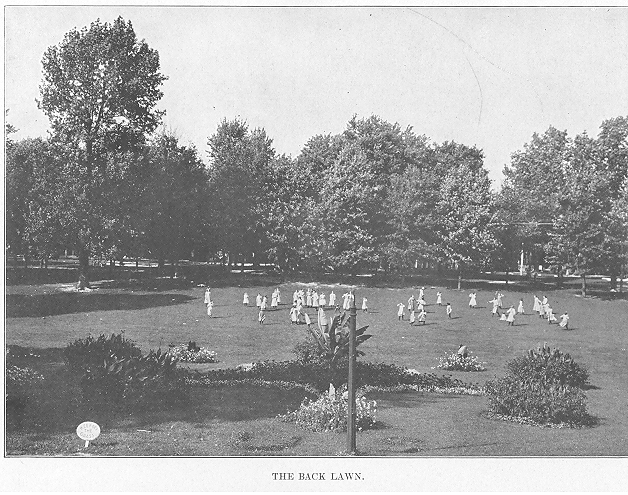
A DESCRIPTION OF THE COUNTY AND ITS TOWNSHIPS - 151
The First Baptist Church of Xenia is situated at the corner of Market and Whiteman Streets. It was organized Nov. 2, 1844, the first pastor being Rev. T. P. Childs. This church is especially noted for having sent out many young men and women
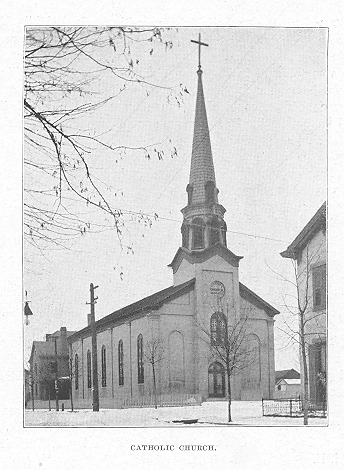
CATHOLIC CHURCH.
who have become leaders in Christian work and in the--missionary field.' The membership is about 170.
On May 31, 1908, was dedicated the new house of worship for the Society of Friends. It is located on Spring Hill. After four years' of work prior to that time in Xenia the Friends felt
152 - GREENE COUNTY 1803-1908.
that they had a work to perform and earnestly set to work to accomplish it. The membership numbers 115.
On Orient Hill there is a neat brick church erected by a recently organized congregation of the Disciples of Christ, which has about 40 members.
Those of the Catholic faith worship at St. Brigid's Church. It has a membership of about 275 families, and is now probably larger in numbers than at any time in its history. The congregation was founded in 1849 and for a time the few families who gathered together for worship were visited by a priest at stated intervals. Then came a permanent. organization, the dedication of the church took place 56 years ago and from that time the congregation has grown and flourished. The first resident ,pastor was Father Blake, who served for the long period of 35 years.
There are a number of, churches in the eastern part of the city where the colored residents of the city worship. The different denominations have able and earnest pastors and much influence is exerted and good accomplished by these Churches.
St. John's A. M. E. Church is located at the corner of Church and Monroe Streets and has a membership of 350. The church was organized over 50 years ago and some of the leaders in church history have been its pastors, several afterwards attaining the office of bishop. It is, considered one of the leading churches of the Ohio A. M. E. Conference.
The Zion Baptist Church is located on East Main Street and has a membership of about 350. It is one of the pioneer churches, having been. organized over 60 years ago. A new building was erected ten years ago at a. cost of $10,000.
Other churches which are doing a splendid work among the colored citizens of the city are the Middle Run Baptist, Third Baptist, Free Will Baptist, Third M..E. Wesleyan, Christian and A. M. E..
Y. M.. C. A. AND SALVATION ARMY.
The Young Men'S Christian Association of Xenia has its .home at the corner of Market and Green Streets. Its spacious airy rooms are inviting haunts for the young men of the city who . avail themselves of its generous privileges, There are now 306
A DESCRIPTION OF THE COUNTY AND ITS TOWNSHIPS - 153
members. The Association was incorporated on June 16, 1884, when it was reorganized. Ground has been purchased in the rear of the present building. on which a modern gymnasium building will be erected at an early date. This building will contain swimming pools, baths, gynmasium floor and running tracks. The Y. M. C. A. owes much to Mr. Eli Millen, one of the city's venerable citizens fOr whom the evening shadows are rapidly lengthening. For many years he furnished the Association a home in the
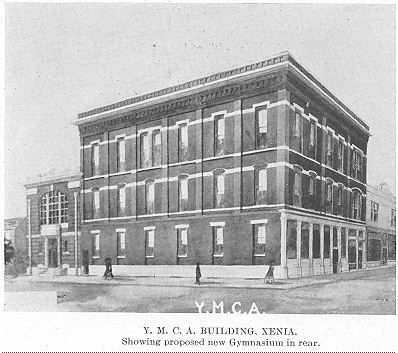
Y. M. C. A. BUILDING, XENIA.
Showing proposed new Gymnasium in rear commodious building which it now occupies and his generosity has made it possible for it to become owner of the same.
The Salvation Army has found much work in Xenia and is constantly aiding the sick, the discouraged, the fallen. When poverty and cold have come upon the poor of Xenia, the Army has been ready with free soup and other provisions and a big dinner for the children of the poor at Christmas time. And in
154 - GREENS COUNTY 1803-1908
the hot clays of the mid summer it has alleviated suffering by furnishing ice and milk to the suffering children of the city. With rare loyalty and without ceasing the band of faithful workers seeks new recruits in the work and aid for the needy.
WOMAN'S CLUBS.
Xenia bears the distinction of having the oldest woman's club in the United States. The Woman's Club of Xenia was organized in March 1867. Its first president was Mrs. Henrietta Monroe, who with one other charter member, Mrs. George Ormsby, still holds her membership. A lecture course under the auspices of the Woman's Club was given during the winter of 1870.. Paul Du Chaillu, Anna Dickinson, Theodore Tilton and George Kennan delighted Xenia audiences. Theodore Tilton, then in the zenith of his fame, Was presented by Mrs. Barlow, president of the Club. He acknowledged the unexpected incident in a very complimentary way, saying 'it was the first time in all his experience as a lecturer that he shad had the honor and the pleasure to be introduced by a woman. Parlor lectures and character impersonations followed at intervals, invited guests giving a social note to such meetings. The Club may be called a pioneer in literary collaboration. In 1887 it was determined to make the unprecedented attempt to collaborate a story : each member contributed a chapter and the result was a delightful romance named "Our Novel." The passing years have brought many changes in Club membership but never interrupted its healthful, harmonious growth and its many avenues of influence have in no small degree stimulated the literary life of Xenia.
The Junior Woman's Club is limited to a membership of twenty and is organized solely for literary purposes. It meets fortnightly at the homes of the members and has proven of much pleasure and profit.
PATRIOTIC ORGANIZATIONS.
The Catharine Greene Chapter, Daughters of the American Revolution, was organized at the home of the late Mrs. Betsy Kendall King, on East. Main Street, December 16, 1894, with nineteen charter members. The Chapter now numbers in all sixty, the resident membership is limited to fifty. The object of
A DESCRIPTION OF THE COUNTY AND ITS TOWNSHIPS - 155
the organization is not only to perpetuate the memory of those who achieved American Independence, but also to encourage patriotism and historical research. The graves of thirteen Revolutionary heroes have been located in the county, three of these have been marked by the Chapter and the others will be marked as soon as sufficient data have been obtained. At different times prizes have been given high school pupils for essays written on historiCal subjects. In 1906 the Chapter placed at Oldtown a large bowlder, properly inscribed, commemorating the running of the gauntlet by Simon Kenton, also marking the location of the largest town of the Shawano Indians and their Council House. In the Carnegie Library the Chapter has been given space for a bOok-case owned by the. Chapter and containing their contribution of sixty volumes of books or reference of historical value to which others will be added from time to time.
The Lewis Post of the G. A. R. now has a membership of 103. There was a time when the organization comprised 300 but the ranks of the veterans are being rapidly depleted and there are few recruits now. The work falling from the shoulders,,of the old soldiers is being taken up by the morejusty Sons of Veterans (Albert Galloway Camp) of which Xenia supports a flourishing Catnp. An important adjunct to the G A. R. is that of Lewis Relief Corps, comprising 67 patriotic women of the city. The work of the Woman's Relief Corps along charitable lines deserves special mention. Lewis Corps has also placed flags in several of the public schools of the county.
OTHER SOCIETIES.
Xenia is rich in lodges and societies, nearly every prominent organization of the country having its society or branch here. And among those for the betterment of the city may be mentioned the Commercial Club. It is composed of the representative business men of the city, its object being the worthy one of promoting the best interest of the city.
The Xenia Driving Club has done much to cultivate a pride in fine horses. The Association was organized in 1901, its object being to furnish a clean sport for the citizens of Xenia and
156 - GREENE COUNTY 1803-1905
vicinity. Matinees are held every week throughout the season with several public race meetings. It is a member of the American Trotting Association and numbers 110 members.
MUSIC.
Xenia can hardly be said as yet to have earned the distinction of being a musical city. However, she possesses a number of talented individual musicians who have received the best of home and foreign training. The McGervey Chorus, organized in 1902 by the late F. E. McGervey as the Y. M. C. A. Chorus, gave annual concerts until the present year and had at one time about 100 members. It is to be hoped that this organization will be continued. The S. of V. Band, led by Walter Curry, is about sixteen years old, and its excellence is well known. It has played in various large cities of the country and has always been enthusiastically received. The Xenia Military Band is a younger organization which has already attained considerable proficiency.
PUBLICATIONS.
Three newspapers occupy the field in Xenia, the Gazette (daily and semi-weekly) and the Xenia Republican and the Xenia Herald (weekly) ; these are treated of in the Historical Sketch.
A monthly publication of much note in the United Presbyterian church is that of The Woman's Missionary Magazine, issued from the job rooms of the Xenia Republican. The editors are Mrs. W. C. Hutchison and Mrs. George Moore ; secretary, Mrs. H. C. Dean; and treasurer, Mrs. S. M. Kelso. Over eight thousand copies of the Magazine are printed each month. The July number, just issued from the press, contained the proceedings of the Woman's General Missionary Convention held at Pittsburg and for this one number alone over four tons of white paper were used. All the women connected with the work of issuing the Magazine give their services without compensation whatever.
"THE EAST END."
In the days of slavery Xenia was noted as one of the points along the line of the "underground railroad," that mysterious, route over which the terrified and fleeing black people were aided by their sympathizers in many a daring midnight ride. (See
A DESCRIPTION OF THE COUNTY AND ITS TOWNSHIPS - 157
the Historical Sketch). Now the eastern part of the city is almost wholly the home of the colored race. Wilberforce University has attracted to this city hundreds of this race who came here in order to educate their children. Have you ever taken a trip to the "East End ?" There you may see the colored "mammy" in all the glory of her red bandana hankerchief forming her headgear, clean starched gingham apron, and a face from which radiates good humor and peace with all the world. And there also may be found the "old fashioned" darky, a gentleman of the old school, if you please, who was brought up to serve his master in the days "befo' de Wah." Time, the great healer, has softened for him .the hardships which he underwent in the days he spent below Mason & Dixon's Jine. The years that have rolled by have mellowed for him the hard places. The big plantations and the cotton fields all hold for him a romantic interest and he talks by the hour of the incidents of his life in the old days. There are few of the old timers left. A new generation has taken their place. They have the advantages of high schools and freedom of thought and speech and many of the colored youth of the city have made a success in many departments of life. They are scattered all over the country. Go where you will, you will find a familiar dark face and the salutation : "From Xenia? I used to live there."
WOODLAND CEMETERY.
Out on Dayton Hill. lies that other city, Woodland Cemetery.. The green sward is kept in perfect order and those who visit the resting place of their loved ones will find Woodland more beautiful than in the days of old. The cemetery comprises forty acre and within it rest dead to the number of 6,818.
THE GREAT FLOOD.
Affliction has come upon us on different occasions but the crowning calamity in the history of Xenia occurred on May 12, 1886. A terrific flood came on, in which the lives of 28 people were sacrificed. The storm occurred between eight and nine o'clock at night. Shawnee, a tiny stream which passed through. a populous part of the city, was converted by a cloud-burst into a torrent of water which descended like an avalanche upon the
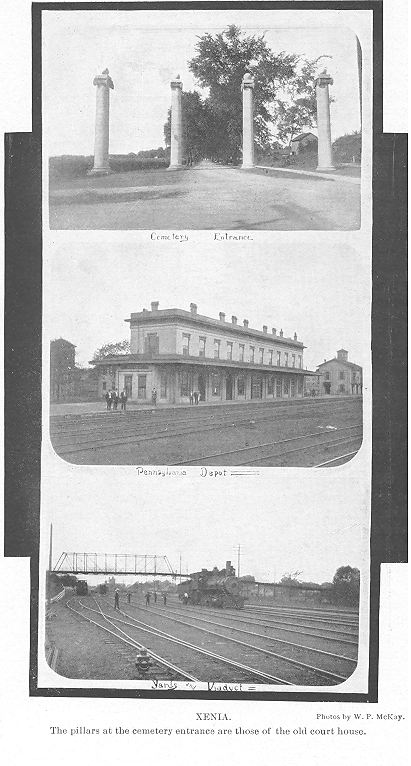
A DESCRIPTION OF THE COUNTY AND ITS TOWNSHIPS - 159
homes of many living in Barr's Bottoms. At ten o'clock the fire bells sounded the alarm and soon another alarm sounded. Dense darkness reigned everywhere but above the roar of the storm and surging waters could be heard the calls of those in distress. It was a night of wild terror and horror. Huge bonfires were built, the shadows of which gave added awe to the scene. There were many heroic deeds performed that night in the efforts to save the drowning, the record of which would form thrilling chapters were it within the province of this brief sketch. Twenty houses were swept away in Barr's Bottoms, near the Little Miami depot, only three remaining. Orrin Morris and his wife and five children perished. The house bearing the family floated down the stream until it struck the solid masonry of a bridge and then all was still. Two children of the family were rescued. The next morning the sun came out bright and warm, disclosing a scene of utter desolation. For a time Xenia was cut off from all communication with the outside world. The office of the mayor was converted into a temporary morgue in which lay the bodies of the dead in somber array. Xenia has had many other calamities but none so great in the loss of life as the great May flood.
We have been favored in many ways. Though fire and flood have scourged us, the people have never for an instant lost faith in the divine guiding hand. At times we have seemed to have gone backward in the moral scale and wrong has triumphed over right but through it all there has been an abiding faith of the people that what is for the best interests of the city will ultimately triumph.
Much work for the good of the city has already been accomplished in the years just passed, but there is still much to be done. The men and women who know Xenia as the "old home" .want to see it thrive and prosper and grow bigger and better. So in this Home-Coming year we welcome them with glad hands, proud of our achievements in the past, humble in the thought that we might have done better, and hoping that' in the. days to come we may make more "of our opportunities, that progress may ever mark our path.
160 - GREENE COUNTY 1803-1908.
GREENE, THE CHAMPION LIVE-STOCK COUNTY.
O. E. BRADFUTE.
IN no one thing has Greene County achieved greater success than in her live-stock interest. Equipped by nature with a most fertile soil which is productive of a great variety of grains in their best estate, having a rolling surface with abundance of water furnished by fine springs and magnificent streams, underlaid with limestone and clothed with blue grass not surpassed even by the famous Blue Grass region of Kentucky—it is little wonder that her people took early to growing high-class and improved live stock. When our grandfathers more than seventy years ago organized the County Fair, little did they dream that their grandchildren would be able tc make a display of live stock, taken from within the county, the equal of which cannot be found in any other county in the nation. Indeed, the battle cry of the stockmen of the county has become, "Greene County Against the Earth." The county is acknowledged to be the foremost one in live stock in the State and the statement is frequently made that within the confines of Greene County can be seen more pure-blood registered live stock, of more kinds and of a higher class, than can be found in any like-sized spot on the globe. The writer has known as many as twenty different live-stock breeders to take their stock from this county to the Ohio State Fair and to bring home with them over $2,000 in prizes on their horses, cattle, sheep and hogs. Nearly every man' had a different kind or class of stock and each stood at the head of his class at that great fair. No other three counties combined in the State equal this county's annual winnings on live
GREENE, THE CHAMPION LIVE-STOCK COUNTY - 161
stock at the State Fair. Several of our stockmen make a business of exhibiting their fine stock at the great fairs and live stock 'shows all over the United States and have established reputations which are not only national but international. Each year pure-blood live stock goes from this county to find homes in nearly every state in the Union, and in countries across the seas.
At the time of the World's Fair at St. Louis, in 1903, five of our live-stock men took their herds and flocks to be present at that great, show ,and strive for the great prizes against the world. They brought home 140 prizes, of which about fifty were first prizes and. championships, including some of the most important prizes given by the Fair. At the International Live Stock Show held annually at Chicago may always be seen a good representation of Greene County's noted stock, and each year is brought home at least one of the coveted championships of the show, 'sometimes two or more of them. A noted bull at the head of one of Greene County's herds has been three times champion at that great show—a record not equalled by any other bull, dead-or alive, in America. 'Another bull which was bred in this county has a record almost equally good. What cattle man of either continent. does not know of Lucy's Prince and Whitehall Sultan ? A Greene County man* was one of the nine who organized the great Chicago show and is still on the board of directors. No county has been so well represented with officers and directors of the leading live-stock pedigree registry associations of America as Greene, having as many as fourteen officials in these various associations.
Greene County boasts of several stables of fine horses ; of great herds of Shorthorn, Aberdeen-Angus, Hereford, Red Poll, Polled Durham, Jersey, Polled Jersey, and Guernsey cattle; of fancy flocks of Merino, Oxford Down, Southdown, Shropshire Down, Cotswold, Hampshire Down, Lincoln, and Cheviot sheep; of showy herds of Poland China, Chester White, Duroc Jersey, and Berkshire swine; to say nothing of many fancy flocks of poultry of various kinds.
One hardly dares name a list of Greene County stockmen
*Mr. Bradfute
162 - GREENE COUNTY 1803-1908.
for fear of omitting names which should be given, yet some stand out so prominently as breeders of a State, national; and international reputation that we venture to mention such names. as Williamson, Watt, Turnbull, Kelly, Bradfute, Gerlaugh, Pollock, Bryson, Cherry, Cummins, Bickett, Foust, Lackey; Peterson, Creswell, Dobbins, Hawkins., Ankeney, Grinnell, Andrew, Jobe, Orr, Corry; and many others might be given with equal propriety.
The reader, when he returns to the old home, should not forget to visit his friends in the country and. let them prove to him that old Greene has kept pace with the world and is the home, not only of some of the finest live stock, but also of some of the happiest and most prosperous people, on earth.
ANTIOCH COLLEGE - 163
ANTIOCH COLLEGE.
JOHN M. DAVIDSON.
THE history of Antioch College is of interest to every student of the history of education in America. The average citizen, even of Greene County, is perhaps unaware that the founding of this college and the formulation of its policy marked an epoch in the history of college education as truly as the public school system of Massachusetts, organized by Horace Mann, marked the turning point in the education of the people's children in the grammar grades. Its importance lay in its frank democracy as opposed. to the aristocratic tendencies of earlier college policy.
Antioch became non-sectarian at a time when nearly all colleges and universities were under sectarian control, and when only three or four state universities were in existence. It abolished the color line at a time when the education of the negro was thought to be impolitic, if not dangerous. It established a scholarship system for the education of those Who otherwise would. have been unable to secure college training; at a time when a college career was generally considered the prerogative of the children of fairly well-to-do parents able to spend money for the education of their children. Finally, Antioch became the first strictly coeducational college in the world. Oberlin, it is true, had before this admitted women to the same class room with men in some studies, but, under the influence of Horace Mann, Antioch was the first college frankly to adopt the democratic policy of preserving absolute equality between men and women, both in the courses of study offered and in the requirements for graduation.
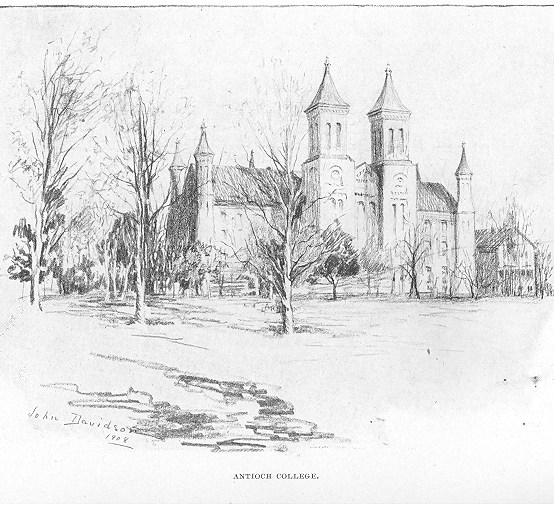
ANTIOCH COLLEGE - 165
Horace Mann, the great reformer and democratizer of the American common school system, was the inspirer of much of the sentiment which brought Antioch into existence, and for that reason was selected as its first president. Upon the clay of his election to the presidency of Antioch, he was also nominated 'for the position of Governor of Massachusetts. He declined the latter honor to take up the former.
The college was organized by the members of the Christian denomination at a convention in Marion, N. Y., in 1850. It was incorporated in 1852, in which. year Mann was elected president,. and it was opened in 1853. No institution has ever attracted to its cause a more distinguished or notable body of supporters than did Antioch. Among the friends and helpers attracted by her ideals were numbered the best minds of the day. Emerson came out to lecture. Edward Everett Hale became a trustee: Horace Greeley, Bayard Taylor, Salmon P. Chase and others also came on to lecture and help. Among her constant friends were numbered Chas. Sumner, Josiah Quincy, Theodore Parker, William Ellery Channing and Wendell Phillips. Great attention was paid to the scholarly and original quality of the work done in the class room and but little towards the securing of new students. Indeed many applicants for admission were turned away for lack of accommodation.
Its history since that time has been one of many vicissitudes. Horace Mann died six years after his election to the presidency and was succeeded by Dr. Thomas Hill, who was called from Antioch to the presidency of Harvard. University in 1862. The war closed the college doors for two years and crippled the institution financially and numerically to such an extent that its prospects for usefulness and influence, which had been so brilliant .under the administration of Mann, were .for some time considerably impaired. It did not, however, prevent the college from preserving its democratic and independent ideals, and keeping up its steady, conscientious, and thoroughly scholarly work.
Its output of men who have made places for themselves in the world of scholarship and letters has been entirely disproportionate to the numbers sent out. Pres. G. Stanley Hall, of Clark
166 - GREENE COUNTY 1803-1908.
CEDARVILLE COLLEGE - 167
University, the late Prof. Langley, of the Smithsonian Institution, Franklin W. Hooper, founder and head of the Brooklyn Institute of Arts and Sciences, Amos R. Wells, editor and author, Dr. George H. Shull, biologist for the Carnegie Institute, Bergen, the botanist, and others are types of the kind of men that hp.ve had their training at Antioch. Original and independent thought and creative work have been almost uniformly characteristic of her successful students, and constitute a striking evidence of the persistence of the democratic and independent spirit which characterized its first president and brought about its foundation.
Under the leadership of Dr, S. D. Fess, who was called in 1906 to the presidency of Antioch from the University of Chicago, the college has entered upon a career of new proMise. It is growing steadily in the number of its students, has strengthened its faculty, and is broadening its activities and sphere of usefulness. Not, perhaps, since the clays of the first president of the college have the prospects for a large and vigorous institution been .so .brilliant. Improvements gradually are being added ; the college has enrolled about three hundred students this year (1908), and the Antioch Chautauqua furnishes instruction and recreation for visitors from all parts of southwestern Ohio. In short, Antioch seems surely to have come into her own.
A word should be said about the buildings and location. The campus faces the glen on the Neff Grounds. It comprises. perhaps ten or fifteen acres, covered by beautiful trees of Many varieties, most of which were set out under the direction of Horace Mann. The main building is one of the most dignified. and beautiful buildings in the county, and has a perfect landscape setting. It is in the form of a cross, one hundred and seventy feet long, with a transept of one hundred and ten feet. It is three stories high, besides the basement, and contains the library, laboratories, museum and class rooms besides. the chapel. Near by stand two dormitories, and at the entrance to the campus stands the president's house.
The distracting elements which go with a large place are missing. "Plain living and high thinking" is the expression which perhaps characterizes best the educational spirit of Antioch.
CEDARVILLE COLLEGE - 167
CEDARVILLE COLLEGE.
PROF. F. A. JURKAT.
CEDARVILLE College is one of the institutions of higher education. under the control of the General Synod of the Reformed Presbyterian Church. The college was chartered in 1887,
and after a delay of several years, was opened for instruction on September 19, 1894, in the mansion formerly owned by Rev. Hugh McMillan, where he conducted an academy half a century ago. In the following year the present building was erected and opened, both campus and building being the gift of generous friends.. The college speedily took high .rank, as is evidenced by the fact that although its. oldest graduates are still young men, they have taken prominent positions in their various professions.
The income of the college consists of tuition fees, collections from congregations, voluntary 'subscriptions and offerings from friends within and without the church, and interest of the endowment funds. The practical origin of the college ivas clue to the liberality of William- Gibson, of Cincinnati, who. bequeathed $25,000 as. a foundation, in memory of his father, Peter Gibson, for many years a prominent member and ruling elder in the ,Cincinnati R. P. congregation. A few years later, Robert M. Cooper, an elder in the Cedarville R. P. congregation, bequeathed a two-thirds interest in his farm, and John R. Lyons, of Marissa, Illinois; gave $500 as a memorial for. his son, James Burney Lyons, who sacrificed his life in the Civil War. In 1905. Mr. and Mrs. G. W. Harper, .of Cedarville, gave $5,000 to found and maintain a chair in Finance and Economics, provided the friends
168 - GREENE COUNTY 1803-1908.
of the college should raise a similar amount. The money, including $1,000 from the Hon. Whitelaw Reid, was raised, and the chair was instituted two years later.
The college plant consists of three buildings ; the main building before mentioned, the gymnasium, and the library. The gymnasium, formerly the R. P. church building, was presented to the college by Mr. W. J. Alford as a memorial to his parents,
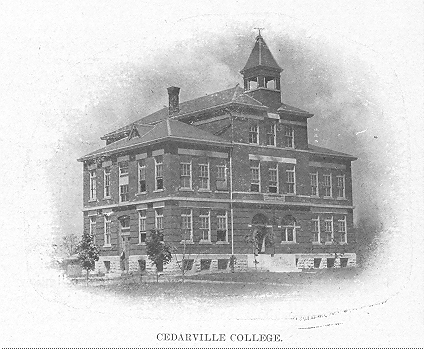
CEDARVILLE COLLEGE.
Rev. and Mrs. John Alford, and was renamed the Alford Memorial. In 1906 Andrew Carnegie presented the college $11,790 to build a library. This building is nearing completion, and is one of the ornaments of the town. It is free to the public.
The present faculty consists of David McKinney, D. D., President; W. R. McChesney, Ph. D., Gibson Professor: of Ancient Languages; F. A. Jurkat, A. M., Modern 'Languages and History; J. R. Fitzpatrick, A. M., Mathematics and Science; Edith Morris, A. B., German and English; Leroy Ph. B.,
CEDARVILLE COLLEGE - 169
Harper Professor of Sociology and Economics ; Mrs. Jessie Russell, Music; and Frank S. Fox, A. M., Elocution.
The graduates to date number ninety-seven. The number of students since the third year of the college has averaged about one hundred.
The collegiate courses offered are two, the classical and the philosophical, leading to the degrees of A. B. and Ph. B., respectively.

CARNEGIE LIBRARY, CEDARVILLE COLLEGE.
Among the students' societies may be mentioned the two literary societies, the Philadelphian and the Philosophic, the Y. M. C. A., the Athletic Association, and the Gavel Club. The latter, formed originally to train its members in parlimentary law, manifests itself most prominently in publishing the college paper, the Gavelyte.
The college has exerted a profound influence upon the community, and in return is thankful that it has such fertile soil to grow in.
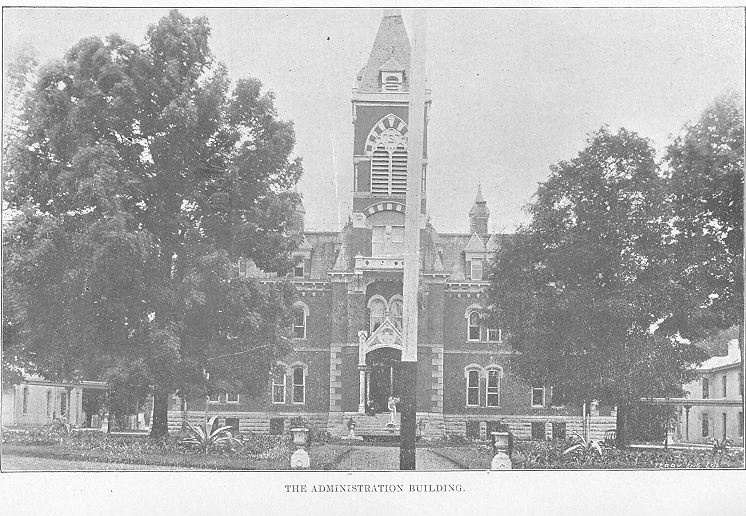
THE O. S. AND S. O. HOME - 171
THE O. S. AND S. O. HOME.
R. C. BARNES, EDITOR OF THE HOME WEEKLY.
THE Home for orphans of the soldiers and sailors of Ohio is located on the brow of a hill standing. a mile south of Xenia. It is an institution to which the people of Xenia are proud to point as the home of the children of the State's war veterans, a large allotment of which were. furnished by Greene County.
The Home is reached by traction and by drive, at the terminus of Home. Avenue standing some forty odd buildings, erected to care for those left dependent by the ravages of the Rebellion and the late Spanish-American conflict.
The Home farm comprises, nearly three, hundred acres of good land, a large part of which is under cultivation. It is situated in one of the best agricultural districts. of the State, and much of the provision for the children is raised on the land. The dairy is one of the important parts of the farm,a herd of thirty Holsteins furnishing milk for the. institution. The floristry department is also an important branch connected with the farm.
There are between seven and eight hundred children residents of this beautiful Hoine, about evenly divided between the sexes. The cottage plah is used, twenty-five-children in a cottage, presided over by a matron. The. life is as near ideal as can be made, everything being done to make surroundings as home-like as possible.
Special stress is put upon the need of education, and the
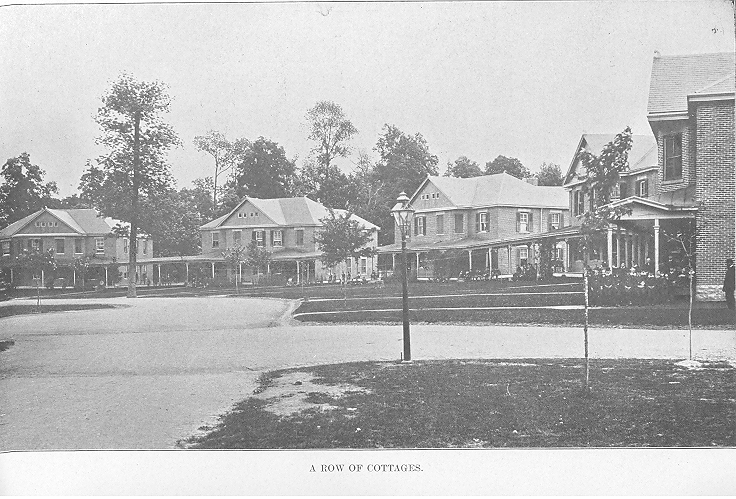
THE O. S. AND S. O. HOME - 173
schools are in charge of a recognized educator and a corps of excellent instructors. The child is given an education in the grammar grades and high schcol and when he leaves, is fitted with a knowledge of the chief branches, and has had his years spent here filled with the mind-training so essential when he leaves to battle against the outside world.
At the age of 14 each boy and girl is required to learn some trade. Of the choices offered girls, the domestic economy course includes instruction in cutting and fitting, and cooking, the tailcring room is open to them, and the stenography and telegraphy departments are open. to both boys and girls. The boys may learn electrical engineering (which includes a school of mechanical drawing), blacksmithing, plumbing, printing, gardening, shoemaking, painting, barbering, tinning; and from the machinists' department a number of excellent workmen are sent out every year.
Each of these departments is fitted with the best of machinery and material, and under the supervision of an instructor or foreman the boys . and girls are permitted to learn. the latest endmost improved manner of carrying on the work.
The hospital is in charge of Dr. W. C. Hewitt, who devotes his time to the work. He resides in the main hospital and has under his charge four wards, each in charge of a trained nurse. A thing for which the people are grateftil is the interest shown by the prominent physicians and surgeons,.who volunteer to come to the institution at any time the emergency reqUires. The Volunteer Consulting and Visiting Staff consists of eighteen of the lest physicians and surgeons in the State.
The boys of the Home are organized into the Home Battalion consisting of four companies, thirteen officers and 281 cadets, and the drill and parades give the Home a military appearance. There are 30 pieces in the band, and. they discourse sweet music on all special occasions.
At Christmas time, the glee of the little ones is beyond the description of words, as they receive their kindly remembrances from the Grand Army, the Woman's Relief Corps and the United Spanish-American War Veterans. The day is never forgotten
